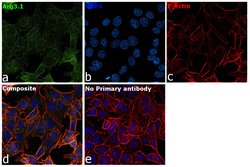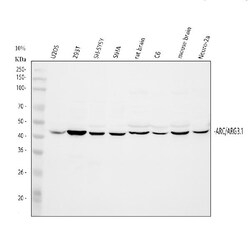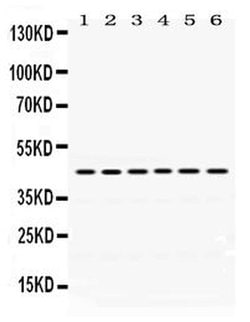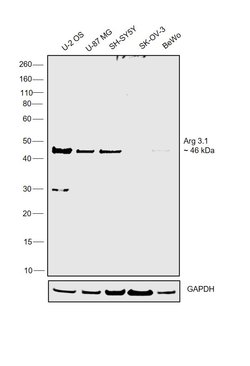Learn More
Invitrogen™ Arg3.1 Polyclonal Antibody
Rabbit Polyclonal Antibody
Supplier: Invitrogen™ PA595315
Description
Reconstitute with 0.2 mL of distilled water to yield a concentration of 500 μg/mL. Positive Control - WB: human U20S whole cell,human 293T whole cell,human SH-SY5Y whole cell,human SiHa whole cell,rat brain tissue,rat C6 whole cell,mouse brain tissue,mouse Neuro-2a whole cell . Store at -20°C for one year from date of receipt. After reconstitution, at 4°C for one month. It can also be aliquotted and stored frozen at -20°C for six months. Avoid repeated freeze-thaw cycles.
Master regulator of synaptic plasticity that self-assembles into virion-like capsids that encapsulate RNAs and mediate intercellular RNA transfer in the nervous system. ARC protein is released from neurons in extracellular vesicles that mediate the transfer of ARC mRNA into new target cells, where ARC mRNA can undergo activity-dependent translation. ARC capsids are endocytosed and are able to transfer ARC mRNA into the cytoplasm of neurons. Acts as a key regulator of synaptic plasticity: required for protein synthesis-dependent forms of long-term potentiation (LTP) and depression (LTD) and for the formation of long-term memory. Regulates synaptic plasticity by promoting endocytosis of AMPA receptors (AMPARs) in response to synaptic activity: this endocytic pathway maintains levels of surface AMPARs in response to chronic changes in neuronal activity through synaptic scaling, thereby contributing to neuronal homeostasis. Acts as a postsynaptic mediator of activity-dependent synapse elimination in the developing cerebellum by mediating elimination of surplus climbing fiber synapses. Accumulates at weaker synapses, probably to prevent their undesired enhancement. This suggests that ARC-containing virion-like capsids may be required to eliminate synaptic material. Required to transduce experience into long-lasting changes in visual cortex plasticity and for long-term memory. Involved in postsynaptic trafficking and processing of amyloid-beta A4 (APP) via interaction with PSEN1. In addition to its role in synapses, also involved in the regulation of the immune system: specifically expressed in skin-migratory dendritic cells and regulates fast dendritic cell migration, thereby regulating T-cell activation.
Specifications
| Arg3.1 | |
| Polyclonal | |
| Unconjugated | |
| Arc | |
| activity regulated cytoskeletal-associated protein; activity regulated cytoskeleton associated protein; activity-regulated cytoskeleton-associated protein; Activity-regulated gene 3.1 protein; activity-regulated gene 3.1 protein homolog; Arc; arc {ECO:0000312; ARC/ARG3.1; Arc3.1; arg3.1; Arg3.1/ARC; C86064; Growth factor ARC; hArc; KIAA0278; mArc; rg3.1; RGD:62037} | |
| Rabbit | |
| Affinity chromatography | |
| RUO | |
| 11838, 23237, 54323 | |
| -20°C | |
| Lyophilized |
| Western Blot, Immunocytochemistry | |
| 500 μg/mL | |
| PBS with 5mg BSA and 0.05mg sodium azide | |
| Q63053, Q7LC44, Q9WV31 | |
| Arc | |
| A synthetic peptide corresponding to a sequence at the C-terminus of human Arc (332-366aa KLKRFLRHPLPKTLEQLIQRGMEVQDDLEQAAEPA). | |
| 100 μg | |
| Primary | |
| Human, Mouse, Rat | |
| Antibody | |
| IgG |
Safety and Handling
Your input is important to us. Please complete this form to provide feedback related to the content on this product.



